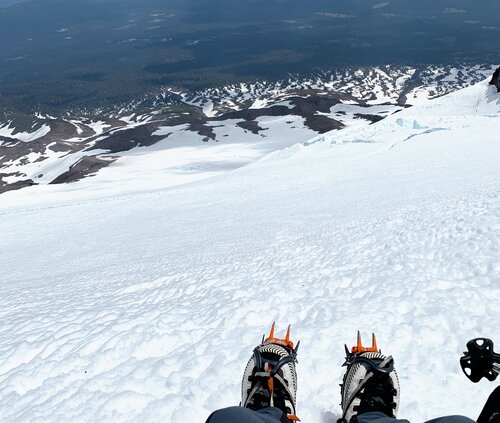Crampons, Microspikes or Snowshoes? What’s a Girl to Choose?
Posted by Alpinistas on Feb 11, 2020
How to make the best decision on what type of traction to pack for your next adventure.
Unfortunately, it isn’t always a straightforward answer! Not only do brand new hikers face this dilemma but also seasoned backcountry gals. We are here to guide you through a few things to think about before setting off on your next adventure.
There are several factors to consider when trying to narrow down the right piece of gear to take along. Terrain, weather, time of year and trail conditions are all important criteria and must be evaluated every time you head out.
While it might be 80 degrees, dry and sunny where you live, the mountain could actually still have patches of snow or ice. If you encounter this with just sneakers or hiking boots, you could be at risk for slipping. If there is any sort of steepness or exposure, you could be entering into some serious consequences if you fall.

On the other hand, if you expect the entire trail to be covered in snow, snowshoes may not always be the best choice. You might be able to move more efficiently wearing crampons. It really all depends.
First, let’s recap the different options that offer traction in the snow and ice.
Snowshoes
Snowshoes attach to your boots to provide flotation in powdery or deep snow. There are also metal points on the bottom to help with firmer snow.
Microspikes
Microspikes are very lightweight metal spikes or nubs attached to a rubber cage. They can fit on almost any type of closed toe shoe. Think of it as something you would wear to walk on an icy driveway to check the mailbox.
Crampons
Crampons are heavier duty metal points that affix to outdoor footwear. There are varying degrees of strength and number of points that are chosen for specific types of mountain activity.
Now Let’s Get Into What Needs To Be Evaluated
1.Terrain & Objective
You need to have a good understanding of what the terrain consists of in order to make a good decision on whether you should bring crampons or just rely on snowshoes.
Are you heading along a mild route to a local lake?
Are you going to try to get to the summit of a mountain?
Will you be hiking a ridge line? Climbing up a couloir?
Steepness and exposure are key factors to determine the correct traction to bring along.
A flat, mild trail might suggest that you use snowshoes or even microspikes.
Getting into steeper terrain could entail using snowshoes or crampons.
Always consider if a trail cuts across a slope that ends in a drop off. If exposed ledges or cliffs and steeper slopes are on your route, the more you might lean towards steel crampons. They will allow for greater mobility and traction if the route gets icy.
You want to plan for worst-case scenarios. Sometimes you might even end up taking two traction options if you are covering a variety of terrain over a long hike.
2.Trail Conditions
Trail conditions based on time of year, recent weather and traffic factor heavily into your choice of traction.
In the winter, you might expect to experience loose, deep powder that is untracked. This would steer you towards snowshoes.
Has the snow warmed up a lot over the last few days and froze overnight?

Has it been a low snow season leaving it compacted and hard packed making? Crampons would be a winner for this.
In the springtime, it could be soft mushy snow or icy crust or just plain ice patches. It is always a debate here between snowshoes and crampons. Has it recently rained or snowed?
Summer can also offer a few snow covered slopes that have a whole variety of conditions or just a few hard packed ice spots here and there...or no snow or ice at all!
A trail that has already had a lot of travelers on it gets packed down. The packed down snow eventually turns into ice. While you could side step the trail when approaching these areas, it isn’t always wise. A highly trafficked path with the potential for some low angle icy spots could call for a light pair of microspikes, just in case.
By taking the time to consider all of the potential variables on your upcoming trip, you will be able to make the best decision on whether to pack crampons, microspikes or snowshoes.
Plan for the riskiest part of your trip. It is better to be over-prepared with a little extra baggage than to be stuck in a dangerous situation with the wrong traction on your feet!
Remember that you are dealing with Mother Nature so nothing will be perfect but hopefully you are armed with enough information to make the best choice.
